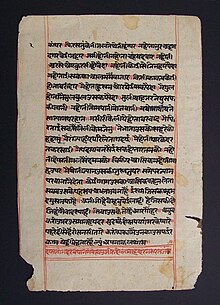Hemp paper
As hemp paper are paper referred exclusively or to a large proportion of pulp consisting of the consist, fibers of Nutzhanfs is recovered. The products are mainly special papers such as cigarette paper , banknotes and technical filter papers . Compared to wood pulp, hemp pulp offers four to five times longer fiber, a significantly lower lignin content and higher tensile , tear and wet strength . However, the production costs are around four times higher than for paper made from wood pulp , so that hemp paper could not gain acceptance for mass applications as printing, writing and packaging paper.
history
The oldest evidence of paper made from hemp fibers from 140–87 BC. BC comes from China and thus represents the oldest paper find in China. Hemp paper became popular in China from around the year 105, but did not reach Europe via the Middle East until the 13th century. In Germany it was first recorded in the 14th century. It was not until the 19th century that processes for the production of paper from wood pulp were established, which were cheaper than the production of hemp paper and superseded it, especially in the field of writing and printing paper.
After the Second World War, industrial hemp was only grown on very small areas. Although the industrial hemp grown in the 1950s and 1960s is harmless due to the almost complete lack of THC , its cultivation has been banned in many countries over the past few decades. In Germany, the cultivation of hemp was completely banned by the Narcotics Act between 1982 and 1995 in order to prevent the illegal use of cannabis as an intoxicant . Especially in France, the industrial hemp varieties continued to be used and cultivated for the production of cigarette paper.
Market shares
The use of hemp fiber for paper production represented 90% of the (legal) use of hemp in Europe at the end of the 1990s, with the release of the cultivation of industrial hemp in other parts of Europe in recent years, the share decreased due to the increase in other types of use (textiles, Natural fiber-reinforced plastics ) to currently around 70 to 80% and is therefore still the most important hemp product line in Europe. Today, hemp for cigarette paper is produced in Spain and Great Britain , among others .
Around the year 2000, the production volume for flax and hemp pulp totaled 25,000 to 30,000 tons per year, which were made from around 37,000 to 45,000 tons of fibers. Up to 80% of the pulp produced in this way is used for special papers (including 95% cigarette paper), only about 20% go into the standard pulp area and are usually mixed with wood pulp in a mostly lower quality (uncleaned tow with high shives content ). In the case of hemp pulp alone, the share of specialty papers is probably around 99%. The market is viewed as saturated, so no or only slight growth is to be expected in this area.
literature
- Ivan Bócsa, Michael Karus, Daike Lohmeyer: The hemp cultivation. Botany, varieties, cultivation and harvest, markets and product lines. 2nd edition, Landwirtschaftsverlag GmbH, Münster 2000.
- Michael Carus et al .: Study on the market and competitive situation for natural fibers and natural fiber materials (Germany and EU). Gülzower Expert Discussions 26, ed. from the Agency for Renewable Raw Materials eV, Gülzow 2008 Download (PDF; 3.9 MB)
- nova-Institut (Ed.): Das kleine Hanf-Lexikon. Verlag Die Werkstatt, Göttingen, 2nd edition, 2003; Page 79. ISBN 3-89533-271-2
- Jürgen Karmann: "Hemp paper." Tribal Paper, Mönchengladbach 2015.
